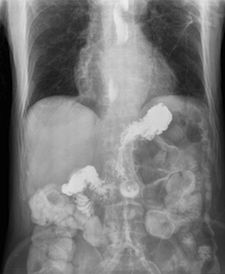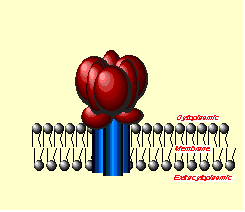



Proton Pump Inhibitors
Caution Proton Pump Inhibitors H2 Blockers
Taking proton pump inhibitors can give a twofold benefit. They can possibly help decrease nexPLD liver cyst formation and they can decrease symptoms of GERD, common with PLD.
Proton Pump Inhibitors are useful for diminishing burping, GERD, gastroesophageal reflux, bloating, and acid reflux. Heartburn is a common symptom of PLD. Hormones trigger PLD liver cyst growth. These same hormone like molecules can cause the digestive system to slow down. The muscles that push the food along the esophagus move much more slowly with hormonal influences. As a PLD liver enlarges, PLD size pushes on the stomach and can sometimes force stomach acid up into the esophagus.
Reflux can be increased by PLD Polycystic Liver Disease size, pregnancy, weight gain, anything which physically increases the pressure from below.
Some things to try to diminish symptoms include:
medications
eating slowly so less air is swallowed (↑ air
↑ pressure)
walking, movement helps ↓ GERD
last meal eaten before 4 pm
eating small meals
diminish the quantity of meals
avoiding foods which increase bloating
avoid foods which relax the valve between the esophagus &
the stomach:
avoid:
pizza
beer
alcohol
yeast
wait 2 - 3 hours before you lie down after eating
smoking or chewing tobacco ↑ GERD
baked goods
chocolate & mint can ↑ GERD
spicy foods ↑ GERD
tomatoes & oranges ↑ GERD
coffee & caffeine ↑ GERD
foods containing carrageenan ↑ GERD
If you continue to have GERD symptoms at night, try raising the head of your bed 6 in. (15 cm) to 8 in. (20 cm)
by putting the frame on blocks or placing a foam wedge under the head of your mattress. (Adding extra pillows does not work.)
How do liver cysts form?
Liver cysts begin as flattened tiny microscopic sacs at the end of liver ducts. These flat microscopic sacs eventually form blind sacs that go nowhere. They connect with nothing. With time, these tiny sacs break off and form very flat microscopic circular pads similar to closed sealed round balloons that are totally flat. When a meal with protein is eaten, the stomach starts to produce acids to digest the meal. These acids eventually turn the stomach contents to acid chyme. Once the pH of the stomach contents becomes acidic, this stimulates secretin hormone to be released. Secretin communicates with another hormone called cyclic AMP. This surrounds the flattened circular envelope like pads within the liver. Once cyclic AMP is informed by secretin release, it begins the process of filling these little sacs with fluid. They start oozing fluid from within the interior of the cyst walls. This creates a water filled cyst. After a bit, these flat circular pads, fill with fluid and form minute microscopic liver cysts. With more time, these microscopic cysts, fill with more fluid, expanding and growing, until the liver has more and more cysts. After many many years, these liver cysts are no longer microscopic. They become noticeable. Sometimes we can feel the filling of fluid especially if the liver cyst can be felt and is close to the surface. Over time, usually years, this process continues until we may notice that we get bloated very quickly following a meal. The water within the cysts has nowhere to go. It creates a belly filled with water balloons. Cystic livers can weigh upwards of 40 pounds. We think we are gaining weight when we are actually losing body fat and becoming very thin and malnourished. Deep breaths become difficult; we eat smaller and smaller amounts of food, from compression of our stomach by ever expanding cysts, sleep becomes difficult to achieve.
Proton pump inhibitors
Histamine 2 receptor antagonist and proton pump inhibitors are prescribed for reflux and GERD An added theoretical benefit is that it diminishes secretin, a hormone that triggers cyclic AMP release. Cyclic AMP activates liver cyst filling with fluid, expansion, growth and enlargement.
How do proton pump inhibitors stop liver cyst growth?
Eating less protein slows down the acidity of the stomach. Proton pump inhibitors diminishes stomach acid chyme. This stops secretin release and this eliminates the trigger for cyclic AMP release and this stops liver cysts from filling with fluid. Without any secretin release, this eliminates the trigger for cyclic AMP. Cyclic AMP release triggers cyst expansion, growth increasing cyst numbers and size. This is the theory. The French discovered that by giving H2 blockers or proton pump inhibitors, following a liver resection, liver cyst fluid was greatly diminished. A few individuals have noted that while taking proton pump inhibitors or H2 blockers, their liver cysts have stabilized and a few have observed that they have decreased.
If the filling of cyst fluid is slowed down then the expanding, growing, and increase in cystic liver size is decreased. This is the theory. The French experience corresponds with this. The finding of secretin induced secretion of liver cysts has prompted clinicians to attempt to slow this process whereby, in theory, slowing down liver cysts growth. This is the same process that the experimental drug octreotide is also looking at. It might be easier to listen to Dr. Torres lecture on polycystic liver disease for a more detailed explanation. There are (2) older research articles. One done by the French following liver resection surgery and a second by a doctor who placed tiny catheters in liver cysts and noted that they enlarged and began filling with fluid in response to secretin. According to one laboratory-polycystic-liver-disease-researcher, liver cysts have 10 - 100 times the amount of cyclic AMP contained within their cells as do polycystic kidney cysts. What this means for us with liver cysts is we should be very careful and take every caution to avoid anything that might trigger an increase in cyclic AMP, i.e., caffeine and even de-caf foods, beverages, and herbs. Chocolate has been among the most difficult for many to avoid. It has long been established that caffeine stimulates cyclic AMP. Increases in cyclic AMP initiates cyst filling, cyst growth, and enlargement. The danger of cyst growth is that internally within the cyst liquid, this produces an inflammation of the surrounding tissue with resultant scar tissue formation. It is this scar tissue that can diminish functioning.Secretin
Insignificant effect of secretin in rodent models of
polycystic kidney and liver disease
Renal and hepatic secretin and secretin receptors and plasma
secretin were increased in both models, and secretin receptor protein was increased in the kidneys and the liver
of mice. However, exogenous secretin administered subcutaneously via osmotic pumps had minimal or negligible
effects and the absence of a functional secretin receptor had no influence on the severity of PKD or PLD.
Therefore, it is unlikely that by itself secretin plays a significant role in the pathogenesis of PKD and/or PLD.
If diminishing secretin is the reason to consider taking H2 blockers, then according to this 2012 article, secretin alone does not play a significant role. However if one has symptoms of GERD, a discussion with your doctor is indicated. With any medication it is always a trade off with side effects vs. benefit.
Side Effects: Have there been an increase in hip fractures in the over 50 crowd from taking proton pump inhibitors?
One study looking at the side effects of proton pump inhibitors found an increase in hip fractures. The study included 13,556 hip fractures and 135,386 controls from the United Kingdom. The researchers looked only at patients ages 50 and older who used acid suppression drugs and controls were matched for sex, age, duration of follow-up. A similar analysis was done for histamine 2 receptor antagonists, which have a weaker acid suppressive effect compared with proton pump inhibitors and do not interfere with osteoclastic proton pumps to reduce bone resorption. Histamine 2 receptor antagonist used for more than one year was also associated with an increase in hip fractures, but a lower risk than proton pump inhibitors. It is this scar formation that contributes to some of the many difficulties and symptoms.Prilosec, Omeprazole
Enjoy taking prilosec for PLD but be cautious about the side effects. It has associated with it gynecosmastia and bone loss with long term use.
Side Effects: Gynecomastia
Some of these drugs may produce gynecomastia in males. Gynecomastia (abnormal breast development and enlargement in men) has been known to occur with: Tagamet (cimetidine), Axid (nizatidine), Prevacid (lansoprazole), Nexium (esomeprazole), omeprazole (Prilosec), Aciphex (rabeprazole) and Pepcid (famotidine). If your doctor prescribes for you any of these drugs ask how it will possibly affect your PLD? PLD cysts have hormone receptors and drugs that are known to cause gynecomastia may also stimulate the hormone receptors of liver cyst walls resulting in a growth of a cystic PLD liver.
Gynecomastia is NOT a reported side effect associated with:
Zantac (ranitidine)
Kapidex
Dexilant (dexlansoprazole)
Pantoprazole (Protonix).
Some common proton pump inhibitors
Aciphex (raberprazole)
Nexium (esomeprazole)
Prevacid (lansoprazole)
Prilosec (omeprazole)
Protonix (pantoprazole)
Side Effects: FDA Warning for Famotidine (Pepcid AC), Nizatidine, Ranitidine
Famotidine family of drugs is excreted primarily by the kidney. This can pose a danger to people with kidney problems. Physicians are now being advised by the US Food and Drug Administration and Health Canada to reduce the dose and increase the time between doses in patients with kidney failure. Use of the drug in those with impaired kidney function can affect the central nervous system and may result in anxiety, depression, insomnia or drowsiness, and mental disturbances.
Some common (H2 blockers) histamine-2 receptor antagonists
Available over the counter and likely to be avoided with PKD/PLD:
Axid (nizatidine) FDA issued kidney disease warning
Cimetidine (Tagamet, Tagamet HB) AVOID this endocrine disruptor
Famotidine (Pepcid AC, Pepcid Oral)FDA issued kidney disease warning
Famotidine Oral Suspension (Pepcid Oral Suspension) FDA issued CKD warning
Nizatidine capsules (Axid AR, Axid Capsules, Nizatadine Capsules)FDA issued warning
Pepcid (famotidine) FDA issued kidney disease warning
Ranitidine (Zantac, Zantac 75)FDA issued kidney disease warning
Ranitidine Effervescent Tablets or Granules (Zantac EFFERdose)FDA issued warning
Ranitidine Hydrochloride Injection (Zantac Injection)FDA issued kidney disease warning
Ranitidine Oral Syrup (Zantac Syrup) FDA issued kidney disease warning
Tagamet (cimetidine) FDA issued kidney disease warning
Zantac (ranitidine) FDA issued kidney disease warning

Nexium
This photo shows acid being pushed into the esophagus from pressure below.
Cimetidine (Tagamet, Tagamet HB)
Cimetidine is the oldest H2 blocker. It has few side effects, although about 1% of people taking it will have mild temporary diarrhea, dizziness, rash, or headache. Cimetidine interacts with a number of commonly used medications, such as phenytoin, theophylline, and warfarin. Long-term use of excessive doses (more than 3 grams a day) may cause impotence or breast enlargement in men. These problems get better after the drug is stopped. This may increase cystic PLD liver growth. It has also been noted in the aging population there is a decrease in kidney functioning associated even with low dose use of cimetidine.How do Proton Pump Inhibitors and H2 Blockers Differ?
Both Proton Pump Inhibitors and H2 Blockers suppress gastric acid secretion. They are, however, different in how they do this. Proton Pump Inhibitors shut down the cell pumps that maintain a stomach acidic environment, H2 Blockers work by blocking signals generated by histamine receptors on cells that are responsible for acid secretion. Proton Pump Inhibitors have a delayed onset of action, while H2 blockers begin working within an hour. Proton Pump Inhibitors most last up to 24 hours, and the effects may last up to three days. H2 Blockers, however, usually only work up to 12 hours.